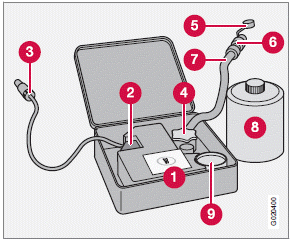Tire sealing system–overview


1 Speed limit sticker
2 On/Off switch
3 Electrical wire
4 Bottle holder (orange cover)
5 Protective hose cover
6 Air release knob
7 Hose
8 Bottle with sealing compound
9 Air pressure gauge
WARNING
Please keep the following points in mind
when using the tire sealing system:
• The sealing compound bottle (no. 8 in
the illustration) contains 1.2-Ethanol
and natural rubber-latex. These substances
are harmful if swallowed.
• The contents of this bottle may cause
allergic skin reactions or otherwise be
potentially harmful to the skin, the central
nervous system, and the eyes.
Precautions:
• Keep out of reach of children.
• Do not ingest the contents.
• Avoid prolonged or repeated contact
with the skin.
• Hands should be washed thoroughly
after handling.
First aid:
• Skin: Wash affected areas of skin with
soap and water. Get medical attention
if symptoms occur.
• Eyes: Flush with plenty of water for least
15 minutes, occasionally lifting the
upper and lower eyelids. Get medical
attention if symptoms occur.
• Inhalation: Move the person to fresh air.
If irritation persists, get medical attention.
NOTE
Do not break the seal on the bottle. This
occurs automatically when the bottle is
screwed into the holder.
See also:
Programming HomeLink
NOTE
Some vehicles may require the ignition
switch to be turned on or to the second
(“accessories”) position for programming
and/or operation of HomeLink. It is also recommended
that a new ba ...
High beam, Halogen
1. Remove the headlight housing from the
vehicle (see page 322).
2. Remove the cover over the bulbs (see
page 323).
3. Remove the bulb by turning it counterclockwise
and pulling it straight ...
Warning/information symbol in center ofthe instrument panel
This symbol shines as a red or
yellow
light depending on the nature
of the information displayed.
Red symbol – Stop the vehicle as soon as
possible in a suitable location and read the
message ...
